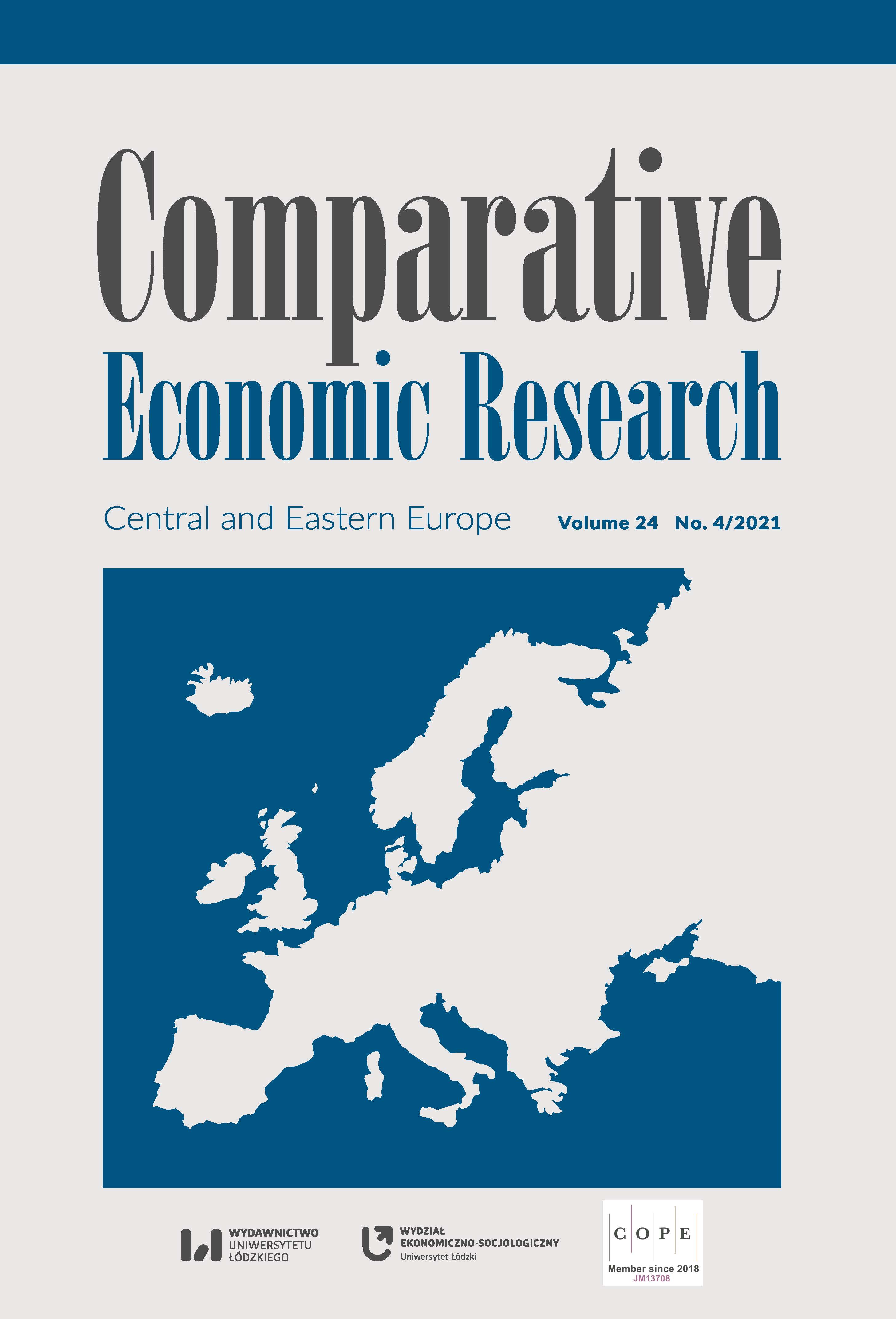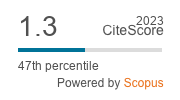Diversification Perspectives of a Single Equity Market: Analysis on the Example of Selected CEE Countries
DOI:
https://doi.org/10.18778/1508-2008.24.32Keywords:
diversification opportunities, CEE stock market, unification benefits, risk-reward tradeoffAbstract
The study addresses the benefits of a unified stock market in terms of diversification risk for the eight CEE stock markets. For this purpose, each stock market was treated as a separate portfolio based on the companies listed during 2018–2019. Portfolio diversification techniques were used to identify risk linked with the eight Central Eastern European stock markets. The results show that the stock market with the lowest diversification risk was the Bulgarian Stock Exchange, followed by the Prague Stock Exchange, the Ljubljana Stock Exchange, and at the end stands the Zagreb Stock Exchange. The portfolio constructed from the Zagreb Stock Exchange carries the highest portfolio risk, but it also offers the highest weekly weighted average returns. Stock markets that benefit in terms of portfolio risk from unification are the Bratislava Stock Exchange, the Budapest Stock Exchange, the Bucharest Stock Exchange, the Warsaw Stock Exchange, and the Zagreb Stock Exchange. The indexes where the portfolio risk increases at the time of unification are the Bulgarian Stock Exchange, the Ljubljana Stock Exchange, and the Prague Stock Exchange. From a managerial perspective, financial investors get a novel outlook on the diversification possibilities offered within a hypothetical unified CEE stock market.
Downloads
References
Abreu, M., Mendes, V. (2010), Financial literacy and portfolio diversification, “Quantitative Finance”, 10 (5), pp. 515–528, https://doi.org/10.1080/14697680902878105
Google Scholar
DOI: https://doi.org/10.1080/14697680902878105
Ajayi, R.A., Mehdian, S., Perry, M.J. (2004), The day-of-the-week effect in stock returns: further evidence from Eastern European emerging markets, “Emerging Markets Finance and Trade”, 40 (4), pp. 53–62, https://doi.org/10.1080/1540496X.2004.11052582
Google Scholar
DOI: https://doi.org/10.1080/1540496X.2004.11052582
Aliu, F., Krasniqi, B., Knapkova, A., Aliu, F. (2019), Interdependence and risk comparison of Slovak, Hungarian, and Polish stock markets: Policy and managerial implications, “Acta Oeconomica”, 69 (2), pp. 273–287, https://doi.org/10.1556/032.2019 .69.2.6
Google Scholar
DOI: https://doi.org/10.1556/032.2019.69.2.6
Aliu, F., Nuhiu, A., Krasniqi, B., Aliu, F. (2020), Modeling the Optimal Portfolio: The Case of the Largest European Stock Exchanges, “Comparative Economic Research. Central and Eastern Europe”, 23 (2), pp. 41–51, https://doi.org/10.18778/1508-2008.23.11
Google Scholar
DOI: https://doi.org/10.18778/1508-2008.23.11
Beckmann, E. (2013), Financial literacy and household savings in Romania, “Numeracy”, 6 (2), https://doi.org/10.5038/1936-4660.6.2.9
Google Scholar
DOI: https://doi.org/10.5038/1936-4660.6.2.9
Berrill, J., Kearney, C., O’Hagan-Luff, M. (2019), Measuring the diversification benefits of investing in highly internationalized firms, “International Business Review”, 28 (4), pp. 672–684, https://doi.org/10.1016/j.ibusrev.2019.01.005
Google Scholar
DOI: https://doi.org/10.1016/j.ibusrev.2019.01.005
Boţoc, C., Anton, S.G. (2020), New empirical evidence on CEE’s stock markets integration, “The World Economy”, 42 (10), pp. 2785–2802, https://doi.org/10.1111/twec.12961
Google Scholar
DOI: https://doi.org/10.1111/twec.12961
Central Bank of Slovakia (2019), The financial literacy support strategy of Narodna Banka Slovensko, https://www.nbs.sk/_img/Documents/_TS/191107/final_nbs_strategiaFinGram_en.pdf (accessed: 25.11.2020).
Google Scholar
Çera, G., Khan, K.A., Mlouk, A., Brabenec, T. (2020), Improving financial capability: the mediating role of financial behavior, “Economic Research-Ekonomska Istraživanja”, 34 (1), pp. 1265–1282, https://doi.org/10.1080/1331677X.2020.1820362
Google Scholar
DOI: https://doi.org/10.1080/1331677X.2020.1820362
Dorn, D., Huberman, G. (2005), Talk and action: What individual investors say and what they do, “Review of Finance”, 9 (4), pp. 437–481, https://doi.org/10.1007/s10679-005-4997-z
Google Scholar
DOI: https://doi.org/10.1007/s10679-005-4997-z
Driessen, J., Laeven, L. (2007), International portfolio diversification benefits: Cross-country evidence from a local perspective, “Journal of Banking and Finance”, 31 (6), pp. 1693–1712, https://doi.org/10.1016/j.jbankfin.2006.11.006
Google Scholar
DOI: https://doi.org/10.1016/j.jbankfin.2006.11.006
Elton, E.J., Gruber, M.J. (1977), Risk reduction and portfolio size: An analytical solution, “The Journal of Business”, 50 (4), pp. 415–437, https://doi.org/10.1086/295964
Google Scholar
DOI: https://doi.org/10.1086/295964
Errunza, V., Hogan, K., Hung, M.W. (1999), Can the gains from international diversification be achieved without trading abroad?, “The Journal of Finance”, 54 (6), pp. 2075–2107, https://doi.org/10.1111/0022-1082.00182
Google Scholar
DOI: https://doi.org/10.1111/0022-1082.00182
Euronext (2020), Regulated markets (Securities and derivatives) operated by Euronext, https://www.euronext.com/en/regulation (accessed: 21.11.2020).
Google Scholar
European Commission (2014), Markets in Financial Instruments (MiFID II) – Directive 2014/65/EU, https://ec.europa.eu/info/law/markets-financial-instruments-mifid-ii-directive-2014-65-eu_en (accessed: 25.11.2020).
Google Scholar
Evans, J.L., Archer, S.H. (1968), Diversification and the reduction of dispersion: An empirical analysis, “The Journal of Finance”, 23 (5), pp. 761–767, https://doi.org/10.1111/j.1540-6261.1968.tb00315.x
Google Scholar
DOI: https://doi.org/10.1111/j.1540-6261.1968.tb00315.x
Guidi, F., Gupta, R., Maheshwari, S. (2011), Weak-form market efficiency and calendar anomalies for Eastern Europe equity markets, “Journal of Emerging Market Finance”, 10 (3), pp. 337–389, https://doi.org/10.1177/097265271101000304
Google Scholar
DOI: https://doi.org/10.1177/097265271101000304
Juncker, J.C. (2014), A new start for Europe: My agenda for jobs, growth, fairness, and democratic change, Political guidelines for the next European Commission. Opening Statement in the European Parliament Plenary Session, 36, https://ec.europa.eu/commission/presscorner/detail/en/SPEECH_14_546 (accessed: 18.11.2020).
Google Scholar
Klapper, L., Lusardi, A., Panos, G.A. (2013), Financial literacy and its consequences: Evidence from Russia during the financial crisis, “Journal of Banking and Finance”, 37 (10), pp. 3904–3923, https://doi.org/10.1016/j.jbankfin.2013.07.014
Google Scholar
DOI: https://doi.org/10.1016/j.jbankfin.2013.07.014
Markowitz, H. (1952), Portfolio selection, “The Journal of Finance”, 7 (1), pp. 77–91, https://doi.org/10.1111/j.1540-6261.1952.tb01525.x
Google Scholar
DOI: https://doi.org/10.1111/j.1540-6261.1952.tb01525.x
Miloş, M.C., Barna, F.M., Boțoc, C. (2020), Multifractal Detrended Fluctuation Analysis (MF DFA) of Stock Market Indexes. Empirical Evidence from Seven Central and Eastern European Markets, “Sustainability”, 12 (2), https://doi.org/10.3390/su12020535
Google Scholar
DOI: https://doi.org/10.3390/su12020535
Moskowitz, T.J., Vissing-Jørgensen, A. (2002), The returns to entrepreneurial investment: A private equity premium puzzle?, “American Economic Review”, 92 (4), pp. 745–778, https://doi.org/10.1257/00028280260344452
Google Scholar
DOI: https://doi.org/10.1257/00028280260344452
Nasdaq Baltic Equity Index (2020), Baltic Market Index Statistics, https://nasdaqbaltic.com/statistics/en/charts (accessed: 10.11.2020).
Google Scholar
Nielsson, U. (2009), Stock market merger and liquidity: The case of Euronext, “Journal of Financial Markets”, 12 (2), pp. 229–267, https://doi.org/10.1016/j.finmar.2008.07.002
Google Scholar
DOI: https://doi.org/10.1016/j.finmar.2008.07.002
Nivet, J.F. (1997), Stock markets in transition: the Warsaw experiment, “Economics of Transition”, 5 (1), pp. 171–183, https://doi.org/10.1111/j.1468-0351.1997.tb00009.x
Google Scholar
DOI: https://doi.org/10.1111/j.1468-0351.1997.tb00009.x
Quaglia, L., Howarth, D., Liebe, M. (2016), The political economy of European capital markets union, “Journal of Common Market Studies”, 54 (51), pp. 185–203, https://doi.org/10.1111/jcms.12429
Google Scholar
DOI: https://doi.org/10.1111/jcms.12429
SEE link (2020), About us, http://www.see-link.net/about-us/15 (accessed: 15.11.2020).
Google Scholar
Statman, M. (1987), How many stocks make a diversified portfolio?, “Journal of Financial and Quantitative Analysis”, 22 (3), pp. 353–363, https://doi.org/10.2307/2330969
Google Scholar
DOI: https://doi.org/10.2307/2330969
Tilfani, O., Ferreira, P., El Boukfaoui, M.Y. (2020), Revisiting stock market integration in Central and Eastern European stock markets with a dynamic analysis, “Post-Communist Economies”, 32 (5), pp. 643–674, https://doi.org/10.1080/14631377.2019.1678099
Google Scholar
DOI: https://doi.org/10.1080/14631377.2019.1678099
Thomson Reuter Eikon Database (2020), Stock price and trade volume data, https://eikon.thomsonreuters.com/index.html (accessed: 15.11.2020).
Google Scholar
Véron, N., Wolff, G.B. (2016), Capital Markets Union: a vision for the long term, “Journal of Financial Regulation”, 2 (1), pp. 130–153, https://doi.org/10.1093/jfr/fjw006
Google Scholar
DOI: https://doi.org/10.1093/jfr/fjw006
Worthington, A., Higgs, H. (2004), Random walks and market efficiency in European equity markets, “The Global Journal of Finance and Economics”, 1 (1), pp. 59–78, https://eprints.qut.edu.au/2319/ (accessed: 15.11.2020).
Google Scholar
Downloads
Published
How to Cite
Issue
Section
License

This work is licensed under a Creative Commons Attribution-NonCommercial-NoDerivatives 4.0 International License.











